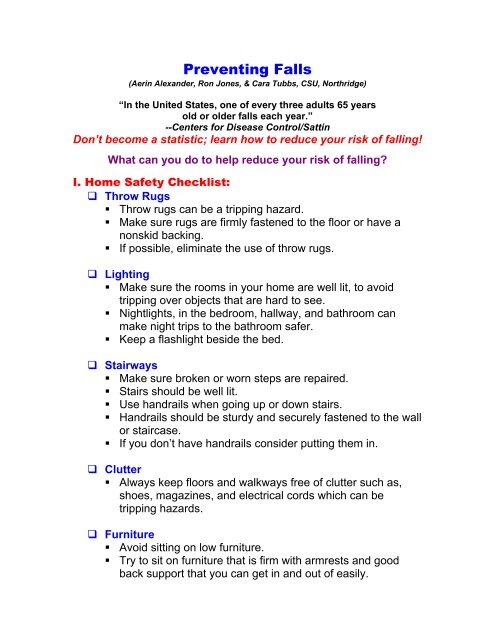Fall Prevention/Home Safety Checklist - RonJones.Org
Fall Prevention/Home Safety Checklist - RonJones.Org
Fall Prevention/Home Safety Checklist - RonJones.Org
- No tags were found...
You also want an ePaper? Increase the reach of your titles
YUMPU automatically turns print PDFs into web optimized ePapers that Google loves.
Preventing <strong>Fall</strong>s(Aerin Alexander, Ron Jones, & Cara Tubbs, CSU, Northridge)“In the United States, one of every three adults 65 yearsold or older falls each year.”--Centers for Disease Control/SattinDon’t become a statistic; learn how to reduce your risk of falling!What can you do to help reduce your risk of falling?I. <strong>Home</strong> <strong>Safety</strong> <strong>Checklist</strong>: Throw Rugs• Throw rugs can be a tripping hazard.• Make sure rugs are firmly fastened to the floor or have anonskid backing.• If possible, eliminate the use of throw rugs. Lighting• Make sure the rooms in your home are well lit, to avoidtripping over objects that are hard to see.• Nightlights, in the bedroom, hallway, and bathroom canmake night trips to the bathroom safer.• Keep a flashlight beside the bed. Stairways• Make sure broken or worn steps are repaired.• Stairs should be well lit.• Use handrails when going up or down stairs.• Handrails should be sturdy and securely fastened to the wallor staircase.• If you don’t have handrails consider putting them in. Clutter• Always keep floors and walkways free of clutter such as,shoes, magazines, and electrical cords which can betripping hazards. Furniture• Avoid sitting on low furniture.• Try to sit on furniture that is firm with armrests and goodback support that you can get in and out of easily.
2 Bathroom• Showers or tubs should have a nonskid surface or mat.• If possible, install grab bars or handrails in the shower, or onthe walls around the bathtub, and alongside the toilet, wherenecessary.• Place a slip-resistant rug next to the shower or bathtub forsafe exit and entry. Kitchen• Immediately clean up spills on the floor.• Store food, dishes, and other cooking items at easy-to-reachwaist high level.• Don’t stand on chairs or boxes to reach upper cupboards.• Use a non-skid floor wax. Clothing/Footwear• Avoid clothing that drags on the ground.• Wear well fitting shoes with firm non-skid, non-friction soles.II. Health and <strong>Safety</strong> <strong>Checklist</strong> Medications• If you take four or more medications per day, you could beat risk for falling.• Multiple medications can cause dizziness, drowsiness andbalance problems.• Review your medications with your doctor at least once ayear. Vision• Cataracts and other vision problems associated with ageingcan impair your vision and cause you to fall.• Have your eyes examined once a year. Hearing• Inner ear problems can cause dizziness that can lead tofalls. Exercise• Exercise can help improve strength, balance, coordination,and flexibility.
3Please Note: This list does not encompass all the risk factors forfalling, nor does it imply that complying with these guidelines willprevent falling from happening. This checklist was developed usinginformation from the CDC and the Temple University <strong>Fall</strong><strong>Prevention</strong> Project for Older Adults (Newton, 1997). For a morecomprehensive list please refer to these websites.(1) <strong>Fall</strong> <strong>Prevention</strong> Project For Older Adults (Temple University): Health and<strong>Safety</strong> <strong>Checklist</strong>: www.temple.edu/older_adult/cioeng.htm orIn-<strong>Home</strong> <strong>Safety</strong> <strong>Checklist</strong>:www.temple.edu/older_adult/IHSCEng.htmFeet and Shoes:www.temple.edu/older_adult/appendixB.htmLow Impact Activity Program:www.temple.edu/older_adult/appendixA.htm(2) San Francisco Department of Public Health<strong>Home</strong> <strong>Safety</strong> <strong>Checklist</strong> Summary:www.dph.sf.ca.us/HealthInfo/<strong>Home</strong><strong>Safety</strong>.htm(3) CDC <strong>Fall</strong>s Among Older Adults:www.cdc.gov/ncip/duip/SummaryOf<strong>Fall</strong>s.htmReferences“Among older adults, falls are the most common cause of injuries andhospital admissions for trauma” (Fife, 1985).Fife, D., & Barancik, J. (1985). Northeastern Ohio Trauma Study III: Incidence offractures. Annals of Emergency Medicine, 14, 244-248.Judge, J., Lindsey, C., Underwood, M., & Winsemius, D. (1993). Balanceimprovements in older women: Effects of exercise training. PhysicalTherapy, 73(4), 254-262.Sattin, R. (1992). <strong>Fall</strong>s among older persons: A public health perspective. AnnualReview of Public Health, 13, 489-508.Tideiksaar, R. (1986). Preventing <strong>Fall</strong>s. Geriatrics, 41(5), 26-28.Tinetti, M., & Speechley, M. (1989). <strong>Prevention</strong> of falls among the elderly. TheNew England Journal of Medicine, 320(16), 1055-1059.Tinetti, M., Speechley, M., & Ginter, S. (1988). Risk factors for falls amongelderly persons living in the community. The New England Journal ofMedicine, 319(26), 1701-1707. www.ronjones.org “High-Performance Health” (12-4-02)













